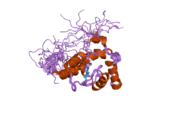SMAP1
| SMAP1 | |||||||||||||||||||||||||||||||||||||||||||||||||||
|---|---|---|---|---|---|---|---|---|---|---|---|---|---|---|---|---|---|---|---|---|---|---|---|---|---|---|---|---|---|---|---|---|---|---|---|---|---|---|---|---|---|---|---|---|---|---|---|---|---|---|---|
 | |||||||||||||||||||||||||||||||||||||||||||||||||||
| |||||||||||||||||||||||||||||||||||||||||||||||||||
| Identifiers | |||||||||||||||||||||||||||||||||||||||||||||||||||
| Aliases | SMAP1, SMAP-1, small ArfGAP 1 | ||||||||||||||||||||||||||||||||||||||||||||||||||
| External IDs | OMIM: 611372; MGI: 2138261; HomoloGene: 134676; GeneCards: SMAP1; OMA:SMAP1 - orthologs | ||||||||||||||||||||||||||||||||||||||||||||||||||
| |||||||||||||||||||||||||||||||||||||||||||||||||||
| |||||||||||||||||||||||||||||||||||||||||||||||||||
| |||||||||||||||||||||||||||||||||||||||||||||||||||
| |||||||||||||||||||||||||||||||||||||||||||||||||||
| |||||||||||||||||||||||||||||||||||||||||||||||||||
| Wikidata | |||||||||||||||||||||||||||||||||||||||||||||||||||
| |||||||||||||||||||||||||||||||||||||||||||||||||||
Stromal membrane-associated protein 1 is a protein that in humans is encoded by the SMAP1 gene.[5][6][7]
The protein encoded by this gene is similar to the mouse stromal membrane-associated protein-1. This similarity suggests that this human gene product is also a type II membrane glycoprotein involved in the erythropoietic stimulatory activity of stromal cells. Alternate splicing results in multiple transcript variants encoding different isoforms.[7]
References
- ^ a b c GRCh38: Ensembl release 89: ENSG00000112305 – Ensembl, May 2017
- ^ a b c GRCm38: Ensembl release 89: ENSMUSG00000026155 – Ensembl, May 2017
- ^ "Human PubMed Reference:". National Center for Biotechnology Information, U.S. National Library of Medicine.
- ^ "Mouse PubMed Reference:". National Center for Biotechnology Information, U.S. National Library of Medicine.
- ^ Sato Y, Hong HN, Yanai N, Obinata M (Sep 1998). "Involvement of stromal membrane-associated protein (SMAP-1) in erythropoietic microenvironment". J Biochem. 124 (1): 209–16. doi:10.1093/oxfordjournals.jbchem.a022082. PMID 9644265.
- ^ Marcos I, Borrego S, Rodriguez de Cordoba S, Galan JJ, Antinolo G (Jul 2002). "Cloning, characterization and chromosome mapping of the human SMAP1 gene". Gene. 292 (1–2): 167–71. doi:10.1016/S0378-1119(02)00645-5. PMID 12119110.
- ^ a b "SMAP1 small ArfGAP 1 [Homo sapiens (human)] - Gene - NCBI". www.ncbi.nlm.nih.gov. Retrieved 2021-05-07.
Further reading
- Maruyama K, Sugano S (1994). "Oligo-capping: a simple method to replace the cap structure of eukaryotic mRNAs with oligoribonucleotides". Gene. 138 (1–2): 171–4. doi:10.1016/0378-1119(94)90802-8. PMID 8125298.
- Suzuki Y, Yoshitomo-Nakagawa K, Maruyama K, et al. (1997). "Construction and characterization of a full length-enriched and a 5'-end-enriched cDNA library". Gene. 200 (1–2): 149–56. doi:10.1016/S0378-1119(97)00411-3. PMID 9373149.
- Strausberg RL, Feingold EA, Grouse LH, et al. (2003). "Generation and initial analysis of more than 15,000 full-length human and mouse cDNA sequences". Proc. Natl. Acad. Sci. U.S.A. 99 (26): 16899–903. Bibcode:2002PNAS...9916899M. doi:10.1073/pnas.242603899. PMC 139241. PMID 12477932.
- Mungall AJ, Palmer SA, Sims SK, et al. (2003). "The DNA sequence and analysis of human chromosome 6". Nature. 425 (6960): 805–11. Bibcode:2003Natur.425..805M. doi:10.1038/nature02055. PMID 14574404.
- Ota T, Suzuki Y, Nishikawa T, et al. (2004). "Complete sequencing and characterization of 21,243 full-length human cDNAs". Nat. Genet. 36 (1): 40–5. doi:10.1038/ng1285. PMID 14702039.
- Gerhard DS, Wagner L, Feingold EA, et al. (2004). "The status, quality, and expansion of the NIH full-length cDNA project: the Mammalian Gene Collection (MGC)". Genome Res. 14 (10B): 2121–7. doi:10.1101/gr.2596504. PMC 528928. PMID 15489334.
- Tanabe K, Torii T, Natsume W, et al. (2005). "A novel GTPase-activating protein for ARF6 directly interacts with clathrin and regulates clathrin-dependent endocytosis". Mol. Biol. Cell. 16 (4): 1617–28. doi:10.1091/mbc.E04-08-0683. PMC 1073646. PMID 15659652.
- Barrios-Rodiles M, Brown KR, Ozdamar B, et al. (2005). "High-throughput mapping of a dynamic signaling network in mammalian cells". Science. 307 (5715): 1621–5. Bibcode:2005Sci...307.1621B. doi:10.1126/science.1105776. PMID 15761153. S2CID 39457788.
- Barragan I, Marcos I, Borrego S, Antiñolo G (2006). "Mutation screening of three candidate genes, ELOVL5, SMAP1 and GLULD1 in autosomal recessive retinitis pigmentosa". Int. J. Mol. Med. 16 (6): 1163–7. doi:10.3892/ijmm.16.6.1163. PMID 16273301.
- Ewing RM, Chu P, Elisma F, et al. (2007). "Large-scale mapping of human protein-protein interactions by mass spectrometry". Mol. Syst. Biol. 3 (1): 89. doi:10.1038/msb4100134. PMC 1847948. PMID 17353931.
- v
- t
- e
-
 2crr: Solution structure of ArfGap domain from human SMAP1
2crr: Solution structure of ArfGap domain from human SMAP1
 | This article on a gene on human chromosome 6 is a stub. You can help Wikipedia by expanding it. |
- v
- t
- e


















